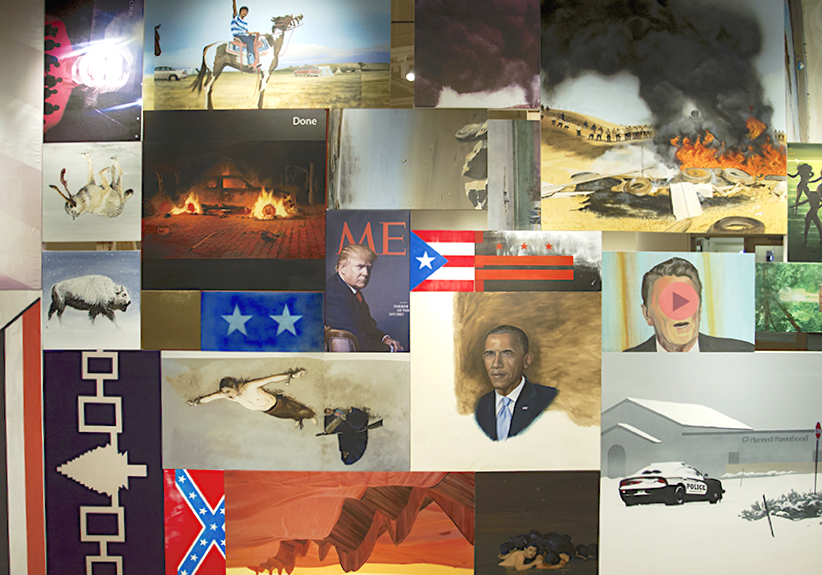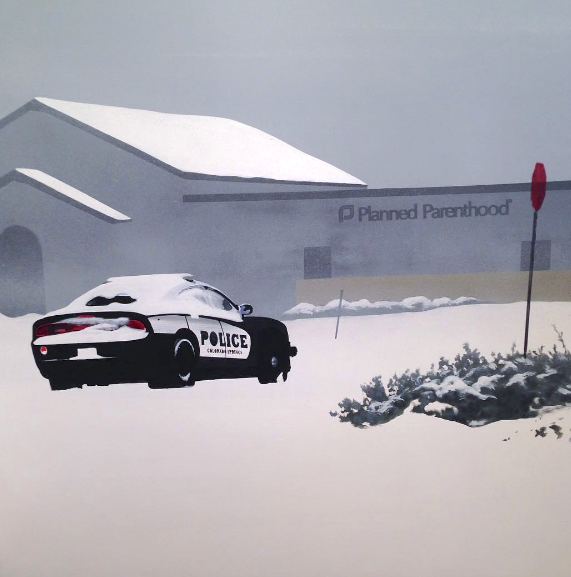The Raven is back with an interview with artist Davin Watne who has an exhibition titled Picture the Wall at Haw/Contemporary in Kansas City until June 24, 2017.
SARAH WALKO: How do you usually start your day? How do you usually end your day?
DAVIN WATNE: I start with breakfast with my family, get everyone up and fed and ready for work or school. This is how I start the day. I end my day by reading in bed, or talking over the day with my wife (very talented artist) Diana Heise.
SW: Do you listen to anything while you work?
DW: Yes, I listen to a lot of political podcasts like The Young Turks, Slate’s Political Gabfest, KCRW To The Point, I also listen to a lot of music like Funk, Latin, Punk Rock, Soul and Reggae.
SW: What is a specific geographical place that you had an experience that served as a threshold or break-through moment in the evolution of your practice?
DW: I was at a residency on the beautiful island of Madeira off the coast of Portugal and I had a room with the most amazing view of the town of Funchal by the ocean. And I would try to paint the ocean at various times of the day, it was so beautiful and I was really captivated by it. At the same time I was experimenting with image transfers on paper. I was really absorbed with ideas of glamour, consumerism, desire and gender politics and using a lot of appropriated imagery as a way to shake up my practice. But it all felt too removed from direct observation. So I tried painting the ocean and then placing the abstracted image transfers on to the seascapes and they became these very surreal landscapes very enigmatic.
Another time I did a research trip to Klawock, Alaska and worked with a master totem pole carver from the Tlingit tribe. He taught me how to carve masks and totem poles as well as some of the myths behind these pieces and their cultural functions. It was so fascinating. I really got to see how art functioned in their society and how it was both similar and different to how art functions in our society. I saw first hand how the environment of the temperate rainforest in Alaska influenced the artworks produced in that region. It helped bring ritual and mystery back into my work which suffers from being overly didactic at times and was very enlightening.

Davin Watne, Installation details, “Imagine the Wall” at Hew Contemporary, Kansas City, Right: Standing Rock Front Lines, 48″x48″, oil and acrylic on panel Left: Crossing the Rio Grande, 24″x 24″, oil and acrylic on panel
SW: Are any of your pieces self portraits?
DW: Not directly, for this current project I did a portrait of my wife Diana when she was pregnant with our daughter Adira. That was a way of recording history through painting that is more personal and can be added to the wall.
SW: Can you talk more about this current project/painting exhibition at Haw Contemporary?
DW: I had an exhibition at Western State Colorado University from January 16 to Feb 17th. It was called “Picture the Wall” and it is an installation of 37 paintings standing 10-feet tall and spanning the width of the gallery. This exhibition functions as sort of portrait of our times and a question how painting can bear witness and help us reflect upon our collective national experience. With the rise of an image economy that traffic in images generated by photojournalists, citizens, news and social media outlets alike, “Picture the Wall” became a way to try to understand everything I was consuming. The wall combines appropriated images, plein air observational works, and graphic representations of flags. I wanted to problematize America, I wanted to consider contemporary methods of representing nationhood, history, and contemporary American politics.
This installation is a collage of individual representations into an impassable wall. I wanted to create a totaling image from fragments. The combination of these fragments ultimately draws attention to the reality that each painting is an illusion, or construction, and not a transparent or unbiased viewpoint.
By painting an image, you have to dissect it, break it down and rebuild it. This process makes you very intimate with an image, and I begin to really understand it and how it works. This is what I want to share with everyone. This has been such an incredible year and historic in the changes and fluctuations the world has gone through, it’s scary. Painting helps me understand things.
SW: What is your relationship with the history of art when you work? Is it something you think about and contextualize your work within?
DW: Yes, I look at a lot of American Art from the 19th and 20th century. Specifically artists like George Bellows, Fredrick Remington, William Merrit Chase, John Singer Sargent. I look at the way they painted, as well as their subject matter. In the canon of Western Art a lot of these artists are kind of panned as being too illustrative and associated with wealthy patrons, American mythologized, ethnocentric in the case of Fredrick Remington. But I think it is worth looking at these artist for how they are reacting to their changing world. Bellows depicts his subjects with a lot of empathy. His depictions of crowded New York tenement houses and poor European immigrant children swimming in the East River is so fascinating. I draw connections to the photo that circulated around a few months ago of Syrian children swimming in a busted water pipe caused by Russian bombing in Aleppo.
The two works of mine that I draw connections between is the painting called “The Flight of the Captive” which is a reference to a painting called “The Captive” by Henry F. Farney. He was an American Western illustrator the piece is from 1880’s illustration in Harper’s Magazine. It shows a US soldier held captive by a Native American tribe. The captive is stripped of his clothes and staked to the ground while the rest of the tribe goes on about their daily routine and an Indian is watching over him covered in a blanket with a rifle on his lap. I compare it, mostly aesthetically with a painting I did of a photograph in the New Yorker magazine from last spring. The image features civilians who formed a militia in Iraq to defend their communities from ISIS and the landscape and colors are so similar to the Farney painting. I want the viewers to make their own tangential relations between my images which come from these seemingly unrelated images.
I love the extreme disconnection between the two men, their respective cultures, their battle for the future of their land and their respective nations. It kind breaks my heart.
SW: When did you start painting?
DW: I started painting in High School and then got into oil painting in college.
SW: How much time do you spend researching and sourcing images in your work? are you always searching around websites and print media or do you just let things jump out at you when they do?
DW: I spend a lot of time researching and sourcing images. The aggregate screen full of images that one sees when they do an image search is what gave me the idea to build a wall of paintings. I tried to make the virtual concrete and impassable.
I’m a news junky, and the images I see in the news from photo journalism and I think this has to be painted. As said before I learn a lot about an image when I paint it. I have the freedom to manipulate the image, like leave something off or change it slightly. It kind of charges it with a different energy. I think about how historically painting was a way to bear witness before photography and now it has lost that purpose. Painting can still bear witness but engender the freedom of symbolic and formal manipulation to expand our understanding of a historic moment.
SW: Are you sea or land? day or night?
DW: Sea, even though I’m land locked and day, even though I work best at night. I love the sunlight.
SW: One living artist you’d love to do a collaboration piece with? One dead one?
DW: I would love to do a collaboration with an artist like Emory Douglas who gained recognition in the late 60’s with the Black Panther movement. I saw him speak a few years ago and he keeps very active and is constantly being invited to help in social justice causes around the world. I would like to create work that defined a visual aesthetic to accompanied a movement like that, and had real world outcomes.
A dead artist I am really interested at the moment is American, Wild West painter Fredrick Remington. I grew up fascinated with his work as a kid, but then kind of fell out with it later in college. His work today is seen as colonialist and guilty of too much mythologized of the American West. It has also spawned a whole genre of imitators, making phony utopic southwestern art. But I would love to see how an artist like Remington would depict the current events at Standing Rock or the oil and gas extraction in North Dakota prairie.
SW: What kind of bird are you?
DW: A vulture.
______________________________________________________
Sarah Walko is the Raven, contributing interviews with other artists to Eyes Towards the Dove.
Davin Watne’s exhibition Picture the Wall at Haw/Contemporary in Kansas City is on view until June 24, 2017.


